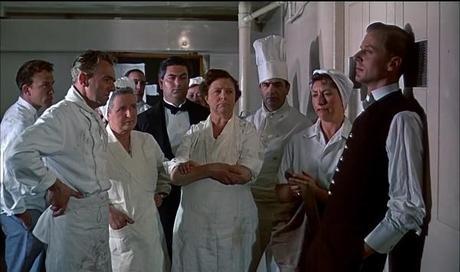Alfred Hitchcock may still reign as the master of suspense some thirty-three years after his death, but many of his most ominous moments and movies were punctuated and accentuated by a nearly irrepressible sense of humor. Hitchcock’s wry wit comes across clearly in the personal introductions he made for the Alfred Hitchcock Presents television series (1955-65) as well as the famous cameo appearances he made in his own films. If you’ve got ten minutes to spare, the magic of YouTube allows you to watch every one of these cameos, starting with 1927′s The Lodger: A Story of London Fog.
The Stanford Theatre in Palo Alto runs a Hitchcock festival every year or two, and this past weekend they did showings of The Man Who Knew Too Much, Hitchcock’s 1956 remake of his earlier 1934 film. The 1956 version stars Jimmy Stewart and Doris Day, and is an excellent example of Hitchcock’s fondness for sprinkling humor on even the most macabre of situations — in this case, the possible death of a child. (I allude to events in this movie but don’t spell out the plot, even though it has been over half a century since its release!)
The film set-up is light-hearted, as Hitchcock offers up a variation of the All-American family that could work within the wholesome confines of a family sitcom of that era. To put this in context, Leave It To Beaver started its run the following year, in 1957. Ben McKenna (Stewart) and his wife Jo (Day) are similar to Beaver’s June and Ward Cleaver, both of them kind and upstanding, raising a boy who makes innocent remarks designed to elicit chuckles in his elders.
HANK: If you ever get hungry, our garden back home is full of snails….We tried everything to get rid of them. We never thought of a Frenchman.

The film commences with several ethnic stereotypes designed to coax chuckles from the audience as Hitchcock sets the scene. There’s the Muslim couple upset when Hank inadvertently rips off the woman’s veil. There’s simultaneous laughter at local customs and the clumsiness of the American tourist as Stewart struggles to eat using only three fingers of his right hand.

Representative of the role of humor in general, rather than falling short of the required seriousness, Doris Day’s penchant for comedy and music make her character Jo all the more compelling. Just before the situation darkens, Ben and Jo stroll through the Marrakech marketplace, making jokes about how their trip has been paid for by Ben’s medical practice.
JO: You know what I was just thinking? You know what’s paying for these three days in Marrakech?
BEN: Yeah, me.
JO: Mrs. Campbell’s gall stones.

The ensuing violence is all the more vivid once we are given a prelude of laughter. This is close to the crossover moment when the film remains in its American family sitcom mood while the suspense has already begun. Joe is unaware of the shift when she delivers a line that could have come from a sitcom script.
JO: Ben, are we about to have our monthly fight?
Hitchcock is fond of this kind of tension created by humor that is operating as light-hearted for some characters while it is doesn’t register as humor at all for others. That’s the situation later in London, when some of Jo’s friends call on the couple and remark on Hank, not knowing about the parents’ worry.
“I hope he looks like you and has the doctor’s brains.”
Similarly, Hitchcock’s moments of fight and flight also contain elements of humor which enhance rather than deflate the excitement, so as the oddities of a scuffle in the taxidermist’s office…

… and Jimmy Stewart rising out of a belltower, in a quasi-foreshadow of his belltower moments in 1958′s Vertigo.
Vertigo also serves as evidence of Hitchcock’s use of the comic in his thrillers. Vertigo revolves around disguise, which is a long-standing tradition of comedies — think of Shakespeare’s characters such as Viola and Portia disguising themselves as men in Twelfth Night and The Merchant of Venice, respectively. In The Man Who Knew Too Much, multiple plot twists revolve around disguise (in the marketplace) and mistaken identity (Ben’s realization about how the couple got involved).
The biggest realization of all, which puts Ben and Jo on the path to discovery, involves wordplay and double meanings. And then there’s the abrupt ending, which involves Ben delivering a joke.
BEN: I’m sorry we were gone so long, but we had to go over and pick up Hank.
All of the humor and light-heartedness allows Hitchcock to fill his movies with those bittersweet moments, operating on two levels. Perhaps the most striking example is when Doris Day sings what would become her signature tune, “Que Sera, Sera (Whatever Will Be, Will Be),” and it winds up being haunting as well as full of life. It’s both light and heavy-hearted.
In the end, one might equate Hitchcock’s films with the embassy setting in which Day’s character Jo sings that song. As one of the unnamed servants states:
“Always something funny going on at this embassy.”

Matthew Daube holds a Ph.D. in Theater and Performance Studies from Stanford University, where he has taught for about half a dozen programs and departments, from Drama to Comparative Studies in Race and Ethnicity. His dissertation, “Laughter in Revolt: Race, Ethnicity, and Identity in the Construction of Stand-up Comedy” argues for the recognition of stand-up comedy as a distinct performance mode that emerged in the United States following World War II, linked to issues of race and focused on the performance of self. He is particularly interested in the intersections between humor and the performance of identity, and has published articles on the use of ethnic stereotype by the Marx Brothers and the role of the audience in stand-up comedy. He is also a founding member of the San Francisco producing company The Collected Works.
